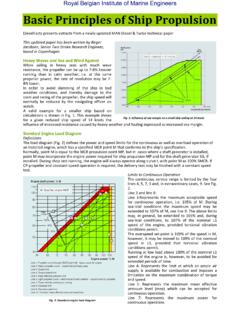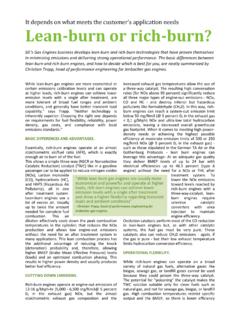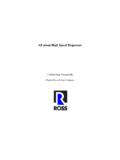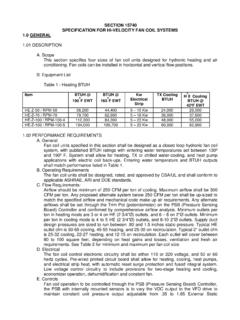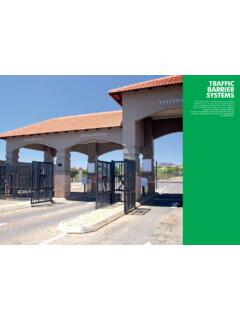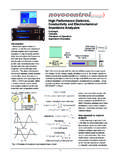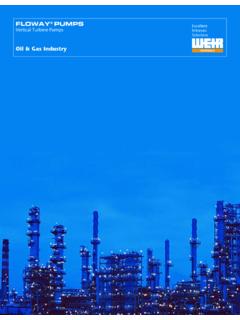Transcription of Bearing up under the pressure - Koninklijk Gallois …
1 Developments in design and materials are improving the reliability and lifetime of low and medium speed engine main and bottom end bearings Main bearings in low speed engines are normally associated with very long lifetimes and in the 20 years from 1970 to 1990 very few failures occurred. Any failures are of concern to operators, however, as the consequences may be fatal. Failures in more recent years could well be a function of higher mean effective pressure ratings in modern engines as well as the latest ship designs, reports the CIMAC Engine Users working group.
2 An investigation by the group showed that Bearing failures in long-stroke engines clearly outweighed those in short stroke designs. The reason could be due to less stiffness of the crankshaft or because most long-stroke engines are installed in tankers and bulk carriers. CIMAC's study also revealed that most of the failures are found on seven-cylinder engines, which are typical in the above ship types. The aft bearings are especially vulnerable, with a definite relationship to weak aft bodies of the ships concerned. It might appear that the requirement for total stiffness is lost between engine and ship designers, the working group suggests. Engine designers have carried out R&D to address the problems, evolving new Bearing designs to handle the higher demands imposed.
3 New calculation techniques are applied to track local high pressure peaks or areas with limited oil film thickness, helping to ensure that current and future engines will perform more safely. Excellent performance is claimed by W rtsil for the crosshead and bottom end bearings of its Sulzer low speed engines, which are of the thin shell white metal type. The main bearings have white metal running layers and are of either thick or thin shell design depending on the engine model. Although the mean loads on the main bearings are lower than those on the bottom end bearings, some white metal damage was reported from the small bore RTA48T and RTA48T-B engines, and also from some RTA96C engines.
4 Proper design of main bearings is very demanding, W rtsil notes, because the crankshaft is distorted by the shaft torque and the aft bearings in the engine are influenced by the inter-mediate and propeller shafts. Inside the engine, distortion of the crankshaft main pin leads to an uneven distribution of Bearing load which leads to edge pressure on the Bearing shells. To verify and calculate this inf1uence on the main bearings, it is essential to create full 3D finite element models of the engine structure along with the complete crankshaft and inter-mediate and propeller shafts. Very precise predictions are made by using elasto-hydrodynamic Bearing calculation methods.
5 The results from such calculations confirm the findings from ships in service. Knowing the exact load distribution at each main Bearing , it is possible to tune the Bearing design accurately to adjust such parameters as oil film pressure and minimum film thickness to the allowable values. An improvement package introduced by W rtsil is designed to overcome the problems with main bearings. it embraces an optimum horizontal Bearing clearance, precise centring of the Bearing cover with the Bearing shell, back relief of the shell to reduce the edge pressure at the running surface, as well as ensuring that the white metal quality and bonding are according to specification. Introduced over three years ago, the improved bearings are now the valid standard design for Sulzer engines, with shipboard service results are reportedly very promising.
6 Occasional failure of a main Bearing can never be excluded, however, because so many factors are involved, says W rtsil . Even so, no ship has had to be stopped by any main Bearing failure and no secondary damage has occurred, it claims. Both thin and thick shell main bearings of Sulzer RTA engines are specified with thick white metal layers to avoid the crankshaft journal touching the base material in the event of Bearing failure. < > Influence of stroke/bore ratio on main Bearing failure cases for low speed engines (CIMAC) Thick shell design original design on the MC engines S50 - S80MC L50 - L90MC K90MC Lined with white metal Improvements introduced Reduced clearances Optimum Lemon Shape Revised alignment procedure Off sets Vertical guide pins Flex edge Thick shell design introduced gradually on the MC engines 26 - 42MC 846 - 890MC-C L60/70/90MC-C K80/90/98MC-C K98MC Lined with white metal or AI8n40 Improvements introduced Revised alignment procedure Off sets Blended edge shells at selected positions Bearing up under the pressure Changes in Bearing shell design for MAN B&W Diesel MC and MC-C low speed enginesRoyal Belgian Institute of Marine Engineers
7 W rtsil has also developed main bearings with running layers of aluminium alloy, the layer thickness the same as those for white metal. The bearings have been tested in the Sulzer 4RT-flex58T-B research engine since 2001 and are running success-fully in a 6 RTA48T-B engine at sea. New recommendations from MAN B&W Diesel aim to simplify and reduce the frequency of Bearing checks and enhance the reliability of its low speed engines. Main, crankpin and cross head bearings in two stroke engines traditionally have been subject to 'open up' inspections every four years, as required by the classification societies.
8 MAN B&W two-stroke engine bearings all feature soft, tribologically-forgiving materials such as tin-based white metal or AISn40. Over the years a number of design improvements, as well as changes to installation practices and alignment recommendations, have been introduced to enhance manufacturing efficiency and reduce the number of Bearing damage cases. Damage statistics are shown in the bar charts, and changes to the two types of main bearings detailed in the diagram. The situation has now been reached, says MAN B&'N, where the scheduled open-up inspections are the most frequent cause of main Bearing damage. This is because the procedure involves a risk of inappropriate handling, incorrect assembly or introducing foreign matter to the Bearing .
9 Main bearings are more demanding than crankpin and crosshead bearings to work with and the most difficult to access (especially the lower part). It might be thought that opening-up inspections are required to monitor the Bearing wear, but the wear of both white metal and AISn40-lined bearings of the types mentioned is virtually nil, MAN B&W claims. The designer has therefore discussed with classification societies waiving the present requirement for such four-yearly inspections. MAN B&W seeks to promote the following change to the recommendations regarding Bearing inspections: comprehensive external checks, including Bearing clearance record checks, checks of Bearing edges as well as visual checks, and checks of the oil pan for possible Bearing metal debris are to be carried out at least once a year.
10 Such a step implies that open-up inspections are only to be carried out if the checks indicate any abnormalities or Bearing damage, thus reducing the possibility of introducing damage to good components. MAN B&W, however will still recommend that the crankpin bearings are opened up for inspection every eight years and crosshead bearings within the first year of service. The crosshead Bearing recommendation is introduced because the overlay in the Bearing during the initial running-in period will adapt to the pin: a process that could lead to excessive material accumulating in the oil wedges. The open-up is desirable to check that these wedges are not blocked; subsequently, the crosshead bearings should only be opened up every six years.

